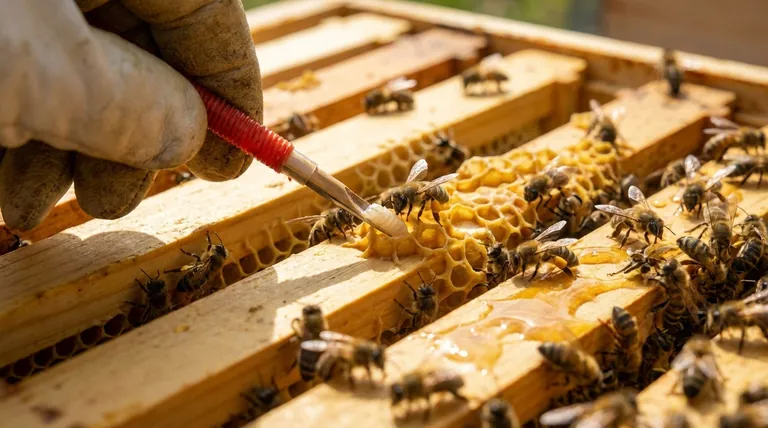At its core, honey production is a two-part process of chemical and physical transformation. Foraging bees collect nectar, a simple sugar-water solution from flowers, and through the addition of enzymes and a meticulous dehydration process, they convert this raw material into the dense, stable, and energy-rich food source we know as honey.
The critical insight is that bees do not simply collect honey; they manufacture it. The entire process is a brilliant feat of natural engineering designed to convert a perishable, watery nectar into a non-perishable, high-energy food that can sustain the colony through winter.

The Journey from Flower to Hive
The creation of honey is a systematic and collaborative effort, with each step serving a specific purpose in refining the final product. It begins with a single foraging bee and ends with thousands of bees working in unison within the hive.
Step 1: Nectar Collection
The process starts when a forager bee visits a flower and uses its long, straw-like tongue, called a proboscis, to drink the nectar.
This nectar is primarily composed of sucrose and water. The bee stores this liquid in a special stomach called a "honey stomach," keeping it separate from its digestive stomach.
Step 2: The Chemical Transformation
While in the honey stomach, the nectar mixes with an enzyme called invertase, which the bee produces. This is the crucial chemical conversion step.
Invertase begins breaking down the complex sucrose into two simpler sugars: glucose and fructose. This process, known as inversion, makes the sugars more digestible and resistant to crystallization.
Step 3: Dehydration and Storage
Back at the hive, the forager regurgitates the nectar-enzyme mixture and passes it to a house bee, who continues the process. This mixture is deposited into a hexagonal wax cell of the honeycomb.
The nectar at this stage is still too watery, with a moisture content of around 70-80%. To prevent fermentation and spoilage, the bees actively dehydrate it by fanning their wings over the cells, creating an airflow that evaporates the excess water.
Step 4: Capping and Curing
The bees continue this dehydration process until the moisture content drops to a critical level, typically below 18.5%.
Once the honey has reached this optimal consistency, the bees seal the cell with a fresh cap of beeswax. This capping protects the finished honey from air and moisture, allowing it to be stored indefinitely.
Why This Process is Critical for Survival
The transformation from nectar to honey isn't arbitrary; it's a solution to the fundamental problem of long-term food storage. Each step in the process contributes to creating a perfect, stable food source.
Preventing Spoilage
The two most important factors in honey's incredible shelf life are its low moisture content and its high acidity.
By reducing the water content below 18.5%, bees create an environment where bacteria and yeast simply cannot survive. The sugars are so concentrated that they draw the water out of any microbes through osmosis, destroying them.
Creating Caloric Density
Removing the vast majority of the water from nectar dramatically concentrates the sugars. This turns a relatively low-energy liquid into an exceptionally dense and efficient fuel source.
This high-calorie food is essential for the colony to generate heat and survive the long, cold winter months when no flowers are available.
The Purpose Behind the Process
Understanding the "how" of honey production reveals the "why" of the bee colony's survival strategy.
- If the primary goal is long-term storage: The key is the dehydration process, which reduces water content to a level that inhibits the growth of bacteria and yeast.
- If the primary goal is creating a high-energy food: The key is the chemical conversion of sucrose and the removal of water, which creates a calorie-dense food perfect for fueling the colony through winter.
Ultimately, honey is the brilliant result of a natural food preservation process, perfected by bees to ensure their survival.
Summary Table:
| Step | Key Action | Purpose |
|---|---|---|
| 1. Nectar Collection | Forager bee drinks nectar from flowers. | Gathers raw material (sucrose & water). |
| 2. Chemical Transformation | Enzyme invertase breaks down sucrose. | Converts sucrose into simple sugars (glucose & fructose). |
| 3. Dehydration & Storage | Bees fan wings to evaporate water from nectar in honeycomb. | Reduces moisture content to prevent spoilage. |
| 4. Capping & Curing | Bees seal the honeycomb cell with wax. | Protects finished honey for long-term storage. |
Fuel Your Beekeeping Success with Premium Equipment
Just as bees meticulously engineer their honey, successful beekeepers rely on high-quality, durable equipment to support their colonies and maximize honey production. HONESTBEE supplies commercial apiaries and beekeeping equipment distributors with the reliable tools needed for efficient, large-scale operations.
Let us help you build a stronger, more productive operation.
Contact our wholesale experts today to discuss your specific needs and discover how our beekeeping supplies can contribute to your success.
Visual Guide

Related Products
- Retractable Chinese Queen Rearing Grafting Tools Equipment
- Electric Heated Honey Uncapping Knife for Beekeeping
- Heart-Shaped Comb Honey Frame and Honeycomb Cassette
- Cotton Beekeeping Suit and Round Hat with Veil Bee Keeper Protective Gear
- White Beekeeping Protective Suit and Hat with Fencing Veil for Beekeepers
People Also Ask
- Why might grafting be a disincentive for beginners in beekeeping? Explore Simpler Queen Rearing Methods
- What is the Doolittle method of queen rearing? Master Controlled Queen Production for Your Apiary
- What is the process of grafting larvae? Master the Art of Queen Rearing for Your Apiary
- What are the key steps in the grafting technique? Master Queen Rearing for a Thriving Apiary
- What are the steps involved in the grafting process? Master Queen Rearing for Your Apiary



















